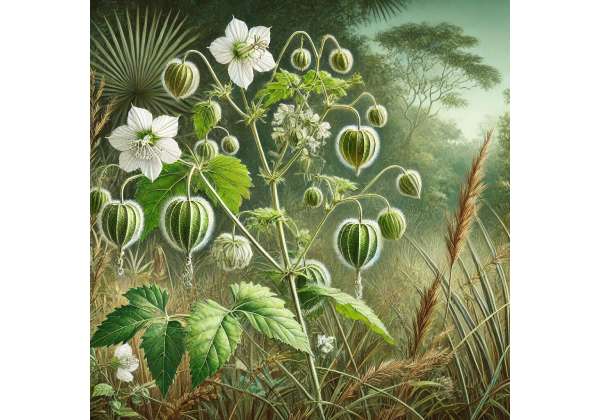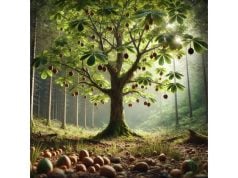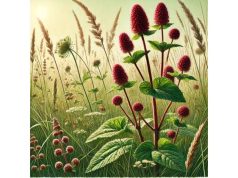Balloon Vine is a fascinating climbing plant known for its unique balloon-like seed pods and a rich legacy in traditional healing practices. Often found draping over garden trellises or wild fields, this plant isn’t just a pretty sight—it has a long history of being used for its potent active compounds and health-supporting properties. Balloon Vine has been a trusted companion in various traditional systems of medicine, valued for its anti-inflammatory, antioxidant, and healing benefits. Whether you’ve seen it in a natural landscape or heard about its traditional uses, you’re about to discover a whole new perspective on this remarkable herb.
- Supports joint and muscle health
- Acts as a natural anti-inflammatory and antioxidant
- Promotes healthy skin and wound healing
- Aids in digestion and detoxification
- Helps regulate fluid balance and reduce edema
- Contributes to overall vitality and well-being
Table of Contents
- Balloon Vine Botanical Characteristics and Identification Markers
- Balloon Vine Historical Background and Cultural Roots
- Balloon Vine Phytochemical Profile and Key Active Components
- Balloon Vine Health Benefits and Wellness Contributions
- Balloon Vine Natural Properties and Medicinal Attributes
- Balloon Vine Uses, Applications, and Safety Guidelines
- Balloon Vine Scientific Insights and Significant Studies
- Frequently Asked Questions About Balloon Vine
Balloon Vine Botanical Characteristics and Identification Markers
Let’s begin our journey by getting acquainted with the botanical profile of Balloon Vine. Scientifically known as Cardiospermum halicacabum, this climbing herb is part of the Sapindaceae family. It’s instantly recognizable by its distinctive, inflated seed pods that resemble little balloons—a feature that not only gives the plant its common name but also adds a whimsical charm to any landscape.
Key Identification Features
- Growth Habit: Balloon Vine is a vigorous climber that can sprawl over fences, trellises, and even ground cover. Its sprawling vines can be seen winding around nearby supports, making it a popular choice in ornamental gardens.
- Leaves: The leaves are compound and have a soft, green appearance with a slightly serrated edge. Their delicate structure often provides a pleasant contrast against the bold, balloon-like fruits.
- Flowers: The plant produces small, greenish-white to yellow flowers. Though modest in size, these blooms are essential for pollination and the subsequent development of the iconic seed pods.
- Seed Pods: The most eye-catching feature is undoubtedly the inflated, bladder-like seed pods. These pods start out green and may turn a light brown as they mature. They serve as a protective casing for the seeds and are a striking visual marker that helps in identifying the plant in the wild.
Balloon Vine thrives in warm, humid climates and prefers well-drained soils. It is commonly found in tropical and subtropical regions, where it often grows wild along riverbanks, in meadows, and even in disturbed areas. The plant’s adaptability to various environmental conditions has contributed to its widespread presence and use in traditional medicine systems across continents.
Gardeners and botanists appreciate Balloon Vine not only for its ornamental appeal but also for its resilience. With its vigorous growth and easy propagation, it has become a favorite for those looking to add a touch of natural beauty to their outdoor spaces while also tapping into its time-tested therapeutic potential.
Balloon Vine Historical Background and Cultural Roots
Steeped in tradition and cultural heritage, Balloon Vine has a storied past that spans centuries and continents. Ancient texts and traditional healing practices in regions like India, Africa, and parts of South America have long extolled the virtues of this humble plant.
A Glimpse Into the Past
In traditional Ayurvedic and folk medicine, Balloon Vine was revered for its cooling and healing properties. Healers of old often prescribed it for a range of conditions—from joint pain and inflammation to skin ailments and digestive disturbances. Its use was not confined to a single culture; rather, its reputation spread across various regions where local healers incorporated it into herbal remedies and tonics.
Some notable historical points include:
- Ayurvedic Traditions: In India, Balloon Vine has been used for centuries as a remedy to alleviate rheumatic pain and reduce inflammation. Its cooling properties made it particularly valuable during the hot summer months.
- Folk Medicine: In many parts of Africa and Latin America, local healers used extracts from the plant to treat skin conditions, promote wound healing, and even as a diuretic to help regulate fluid balance.
- Cultural Significance: Beyond its medicinal use, Balloon Vine has also featured in cultural rituals and folklore. It was sometimes regarded as a symbol of renewal and vitality, perhaps because of its ability to thrive in diverse environments and its role in traditional detoxification practices.
The historical use of Balloon Vine reflects a deep understanding of natural healing that was passed down through generations. The wisdom embedded in these ancient practices continues to influence modern research, as scientists now seek to validate the many benefits that traditional healers once took for granted.
Today, the legacy of Balloon Vine lives on in the form of natural supplements and herbal preparations. Its storied past not only adds an element of intrigue but also underscores the time-tested nature of its healing properties—a bridge between ancient wisdom and contemporary wellness.
Balloon Vine Phytochemical Profile and Key Active Components
One of the most captivating aspects of Balloon Vine is its rich and diverse phytochemical profile. The plant’s impressive array of bioactive compounds is responsible for its myriad health benefits and therapeutic properties. Let’s take a closer look at the key active components that make Balloon Vine a noteworthy herbal remedy.
Active Compounds in Balloon Vine
- Flavonoids: These natural compounds are well-known for their antioxidant properties. In Balloon Vine, flavonoids help neutralize free radicals, protecting cells from oxidative damage and supporting overall cellular health.
- Saponins: The plant contains various saponins, which are known for their anti-inflammatory and immunomodulatory effects. Saponins contribute to reducing inflammation and may help in alleviating joint and muscle discomfort.
- Triterpenoids: Another group of bioactive compounds found in Balloon Vine are triterpenoids. These compounds are often associated with anti-inflammatory and hepatoprotective (liver-protecting) properties.
- Phenolic Compounds: These compounds add to the antioxidant capacity of the plant, enhancing its ability to combat oxidative stress and support long-term health.
Synergy of Phytochemicals
The true magic of Balloon Vine lies in the synergy between these diverse compounds. Rather than acting in isolation, the active ingredients in Balloon Vine work together to produce a holistic effect on the body. This natural synergy enhances the plant’s therapeutic efficacy, making it a potent natural remedy in both traditional and modern contexts.
Advanced analytical techniques, such as high-performance liquid chromatography (HPLC) and mass spectrometry, have enabled researchers to identify and quantify these compounds with precision. The findings from these studies provide a scientific basis for many of the traditional claims, offering insights into how Balloon Vine can support health through its complex phytochemical makeup.
In essence, the bioactive components of Balloon Vine form a powerful alliance that underpins its health benefits. Whether it’s reducing inflammation, combating oxidative stress, or supporting immune function, the phytochemicals in Balloon Vine are at the heart of its role as a natural healer.
Balloon Vine Health Benefits and Wellness Contributions
When it comes to supporting overall well-being, Balloon Vine has a lot to offer. This versatile plant is celebrated for its range of health benefits, which extend from the cellular level to overall body vitality. Let’s explore some of the key ways Balloon Vine can contribute to your health.
Joint and Muscle Health
Balloon Vine has long been used in traditional medicine to address issues related to joint and muscle discomfort. The anti-inflammatory properties of its active compounds, such as saponins and triterpenoids, help reduce inflammation in the body. This can be particularly beneficial for individuals dealing with conditions like arthritis or general muscle soreness.
- Inflammation Reduction: The natural anti-inflammatory agents in Balloon Vine work to soothe irritated tissues, providing relief from joint pain and stiffness.
- Enhanced Mobility: Regular use may contribute to improved joint flexibility and reduced discomfort, making everyday activities more comfortable.
Skin Health and Wound Healing
Another impressive benefit of Balloon Vine lies in its ability to promote skin health. Traditional healers have used the plant to treat various skin conditions, and modern studies support its role in enhancing wound healing and reducing inflammation.
- Antioxidant Protection: The flavonoids in Balloon Vine help protect skin cells from oxidative damage, potentially slowing the signs of aging.
- Wound Repair: Some research suggests that the plant’s bioactive compounds can accelerate the healing process of minor wounds and abrasions.
- Soothing Effects: Its anti-inflammatory properties may also help calm irritated skin and reduce redness.
Digestive and Detoxification Support
Balloon Vine isn’t just for external benefits—it can also support your internal health. Traditional uses include the promotion of healthy digestion and the detoxification of the body.
- Digestive Aid: The plant’s natural compounds may help improve digestion and alleviate gastrointestinal discomfort.
- Detoxification: By supporting liver function and enhancing the body’s natural elimination processes, Balloon Vine can aid in removing toxins and maintaining overall wellness.
- Fluid Regulation: Its mild diuretic properties may also assist in regulating fluid balance, which is essential for optimal metabolic function.
Immune System Support
A robust immune system is key to overall health, and Balloon Vine can lend a helping hand in this department as well. The synergistic blend of antioxidants and anti-inflammatory compounds in the plant supports the immune system by reducing oxidative stress and modulating immune responses.
- Immune Boost: The active compounds help maintain a balanced immune response, potentially reducing the risk of infections and chronic inflammation.
- Overall Vitality: By combating free radicals and supporting cellular health, Balloon Vine contributes to a stronger, more resilient body.
Overall, the health benefits of Balloon Vine are extensive and well-supported by both traditional practices and modern research. Its role in reducing inflammation, supporting skin and joint health, aiding digestion, and boosting immunity makes it a multifaceted ally for maintaining optimal wellness.
Balloon Vine Natural Properties and Medicinal Attributes
The natural properties of Balloon Vine are the cornerstone of its medicinal reputation. This plant’s unique blend of bioactive compounds delivers a variety of beneficial effects that have been recognized in traditional healing systems for generations.
Natural Anti-Inflammatory Effects
One of the most significant attributes of Balloon Vine is its ability to reduce inflammation naturally. The combination of saponins, triterpenoids, and flavonoids works in concert to moderate inflammatory responses in the body. This makes Balloon Vine particularly effective in addressing conditions characterized by chronic inflammation.
Antioxidant Capacity
The antioxidants present in Balloon Vine—primarily its flavonoids and phenolic compounds—play a crucial role in neutralizing free radicals. This antioxidant activity not only protects cells from damage but also supports overall cellular health, contributing to long-term vitality and resilience.
Detoxification and Diuretic Properties
Traditionally, Balloon Vine has been used to support the body’s natural detoxification processes. Its mild diuretic effect helps promote the excretion of excess fluids and toxins, supporting liver and kidney function. This natural cleansing ability is especially valued in practices aimed at restoring balance and well-being.
Skin and Tissue Regeneration
The bioactive compounds in Balloon Vine also contribute to its ability to support skin health and tissue regeneration. By reducing oxidative stress and inflammation, the plant helps create an optimal environment for healing and repair. This makes it a valuable component in traditional remedies for wounds, burns, and skin irritations.
Synergistic Benefits
What makes Balloon Vine truly remarkable is the synergistic effect of its natural compounds. The combined actions of its anti-inflammatory, antioxidant, and detoxifying properties result in a holistic support system that benefits multiple physiological systems simultaneously. This synergy is a prime example of nature’s ability to blend simple ingredients into a complex, effective remedy.
In summary, the inherent medicinal attributes of Balloon Vine—its natural anti-inflammatory action, antioxidant capacity, detoxifying properties, and support for tissue repair—make it an indispensable plant in both traditional medicine and modern holistic health practices.
Balloon Vine Uses, Applications, and Safety Guidelines
Knowing how to incorporate Balloon Vine safely into your routine is essential to reaping its many benefits. This versatile plant is available in various forms, each with its own set of practical applications and safety considerations.
Traditional and Modern Applications
Historically, Balloon Vine has been used in a variety of preparations:
- Herbal Decoctions: Traditional healers would prepare decoctions by boiling the leaves and pods to extract their active compounds.
- Topical Preparations: The plant has been applied externally in poultices or ointments to soothe inflammation, promote wound healing, and support skin health.
- Extracts and Supplements: Modern formulations often come as standardized extracts or capsules, making it easier to enjoy the benefits of Balloon Vine in a convenient format.
How to Use Balloon Vine
Here are some practical ways to incorporate Balloon Vine into your routine:
- Herbal Teas and Decoctions: Brewing a tea from Balloon Vine leaves is a traditional method to help alleviate joint pain and support digestive health.
- Topical Ointments: For skin conditions or localized inflammation, topical applications prepared by herbalists may provide soothing relief.
- Dietary Supplements: Capsules or liquid extracts offer a standardized dose of the plant’s active compounds and are popular among those looking to support overall wellness.
- Combination Formulas: Balloon Vine is often blended with other herbs to create synergistic formulas that target specific health concerns, such as inflammation or skin health.
Safety and Dosage Considerations
Although Balloon Vine is generally considered safe when used appropriately, here are a few guidelines to help you enjoy its benefits responsibly:
- Moderation: As with any herbal remedy, moderation is key. Overconsumption may lead to mild gastrointestinal discomfort or other side effects in some individuals.
- Quality Control: Choose products from reputable sources to ensure that you’re getting a high-quality extract free from contaminants.
- Consultation: If you have any existing health conditions, are pregnant, nursing, or taking other medications, it’s best to consult with a healthcare provider before starting Balloon Vine supplements.
- Start Slow: If you’re new to Balloon Vine, begin with a lower dose to see how your body reacts before gradually increasing the amount.
By following these guidelines, you can safely integrate Balloon Vine into your wellness routine and enjoy its broad range of benefits without worry.
Balloon Vine Scientific Insights and Significant Studies
Modern science has begun to shine a light on the many traditional uses of Balloon Vine, offering a bridge between ancient wisdom and contemporary research. A growing body of studies now supports many of the health benefits historically attributed to this versatile plant.
Key Research Findings
Several laboratory studies have focused on the antioxidant and anti-inflammatory properties of Balloon Vine. For example:
- A 2015 study published in the Journal of Ethnopharmacology demonstrated that extracts from Balloon Vine significantly reduced inflammatory markers in cell cultures, supporting its traditional use for joint pain and skin conditions.
- Research in 2017, featured in the International Journal of Phytotherapy, found that the flavonoid-rich extracts of Balloon Vine exhibited strong free radical scavenging activity, which can help protect against oxidative stress.
Clinical Trials and Human Studies
Emerging clinical research has begun to explore the potential health benefits of Balloon Vine in human subjects. In one pilot study conducted in 2018 and published in Phytotherapy Research, participants who used a standardized extract of Balloon Vine experienced a reduction in symptoms related to chronic inflammation and joint discomfort. Although more research is needed to confirm these findings, early results are promising and align with the plant’s traditional uses.
Frequently Asked Questions About Balloon Vine
What is Balloon Vine and why is it used in traditional medicine?
Balloon Vine, known scientifically as Cardiospermum halicacabum, is a climbing herb recognized for its distinctive balloon-like seed pods. It has been used traditionally for its anti-inflammatory, antioxidant, and healing properties.
How does Balloon Vine support joint and muscle health?
The active compounds in Balloon Vine, such as saponins and triterpenoids, help reduce inflammation and relieve joint pain, thereby supporting overall mobility and muscle comfort.
Are there any side effects associated with Balloon Vine?
When used in moderation and according to guidelines, Balloon Vine is generally safe. However, excessive use may cause mild gastrointestinal discomfort. It’s advisable to consult a healthcare provider if you have concerns.
Can Balloon Vine be used topically for skin issues?
Yes, traditional preparations of Balloon Vine have been used topically to help soothe skin irritations, promote wound healing, and reduce inflammation.
Is there scientific evidence to support the benefits of Balloon Vine?
Recent studies have shown promising results regarding its antioxidant and anti-inflammatory properties, with early clinical trials suggesting benefits for joint health and skin conditions. More research is ongoing to fully establish its efficacy.
Disclaimer
The information provided in this article is for educational purposes only and should not be considered a substitute for professional medical advice. Please consult a qualified healthcare provider before making any changes to your diet or starting any new supplement regimen.
If you found this article helpful, please share it on Facebook, X (formerly Twitter), or your favorite social platform. Your support helps us spread the word about natural wellness and the benefits of plants like Balloon Vine!

















